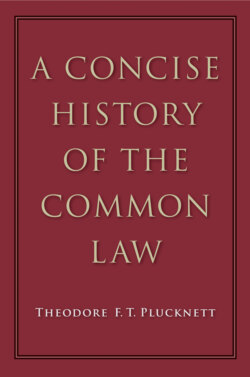Читать книгу A Concise History of the Common Law - Theodore F. T. Plucknett - Страница 151
На сайте Литреса книга снята с продажи.
JUSTICES OF THE PEACE
ОглавлениеBesides these travelling commissions, both new and old, which were sent through the country from Westminster, there developed a different type of commission composed of local gentry who were assigned first to keep the peace, and afterwards to be justices of the peace. From the end of the twelfth century local knights and gentry, often described as “keepers of the peace”, were occasionally called upon to co-operate with the sheriff in enforcing law.2 Their duties were principally of an administrative and police character. The Statute of Winchester (1285) laid down the rudiments of a scheme for maintaining order, but created no machinery for carrying it out. It thus became the practice to set up commissioners under varying titles to enforce the statute. From the beginning of Edward III’s reign a stream of legislation begins to enlarge their powers. Nor were their powers entirely statutory, for the Crown frequently increased or diminished the powers of keepers of the peace merely by changes in the terms of their commission, and regardless of the state of the statutory law existing at the moment.3 As before, they were to receive prisoners and to produce them to the justices of gaol delivery—and here it seems that the Crown showed some distrust of the sheriff who ordinarily would have performed these duties; indeed, the justices of gaol delivery were given authority in 1330 to punish the sheriff if he abused his powers of releasing prisoners upon bail.4 Very soon the keepers of the peace were allowed not only to keep prisoners, but to try them; in 1344 it was enacted “that two or three of the best people of each county should be assigned as guardians of the peace by the King’s commission”, and that these keepers should be associated with lawyers in a commission of oyer and terminer for the trial and punishment of felonies and trespasses against the peace.1 There was some hesitation about entrusting wide powers to the keepers of the peace, and legislative policy fluctuated;2 but the keepers (now called “justices”) by themselves, without the association of professional lawyers with them, exercised judicial powers regularly from 1368 onwards.3
Meanwhile, in 1349 came the Black Death, and in 1351 began the Statutes of Labourers, which attempted to regulate the disorganised labour market. This labour legislation set up elaborate machinery for fixing prices and wages and enforcing labour contracts, and established “justices of labourers” for the difficult task of enforcing it. Shortly afterwards the keepers of the peace and the justices of the labourers were merged into one commission with the new title of “justices of the peace”,4 which first appears officially in 1361. For the rest of the middle ages, and indeed ever since, hardly a Parliament passed without adding some new duty to the work of the justices of the peace. At first they received salaries payable out of the fines which they inflicted, but as time went on the change in the value of money made their wage too small to be worth collecting; it has now long been obsolete.5 They were and generally still are laymen and not lawyers,6 but it must be remembered that during the middle ages the average landowner had a fairly good knowledge of elementary law; what further technical assistance they needed was supplied by the clerk of the peace who served as a professional clerk to the justices. The clerk of the justices was frequently appointed also to the office of clerk of the Crown, the duties of which were to act as a permanent local secretary to the travelling justices who came down from Westminster to hold the pleas of the Crown. The clerk of the peace was technically the deputy appointed by the Custos Rotulorum, a mysterious official of whose history very little is known.7
The justices of the peace, like most other mediaeval bodies, held two sorts of meetings, large and small. The large meetings held four times a year are called quarter sessions. In the fourteenth century they must have looked something like the older Eyre, although on a smaller scale. Grand juries were charged, made presentments, and the persons so indicted were forthwith tried. Until the eighteenth century, quarter sessions tried capital cases, which after that date they reserved for the Justices of Assize. Quarter sessions also possessed an appellate jurisdiction from petty sessions. Petty sessions on the other hand consisted of two or more justices acting in the most informal manner for minor business and the lesser offences entrusted to them for summary trial without a jury, by virtue of numerous statutes in Tudor times and later.1 Both quarter and petty sessions were ultimately subject to the Court of King’s Bench, which by a writ of certiorari could remove and review their proceedings.
